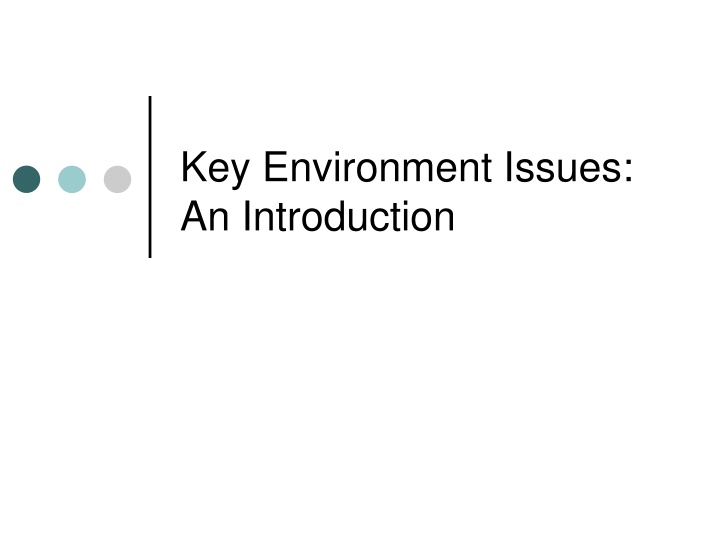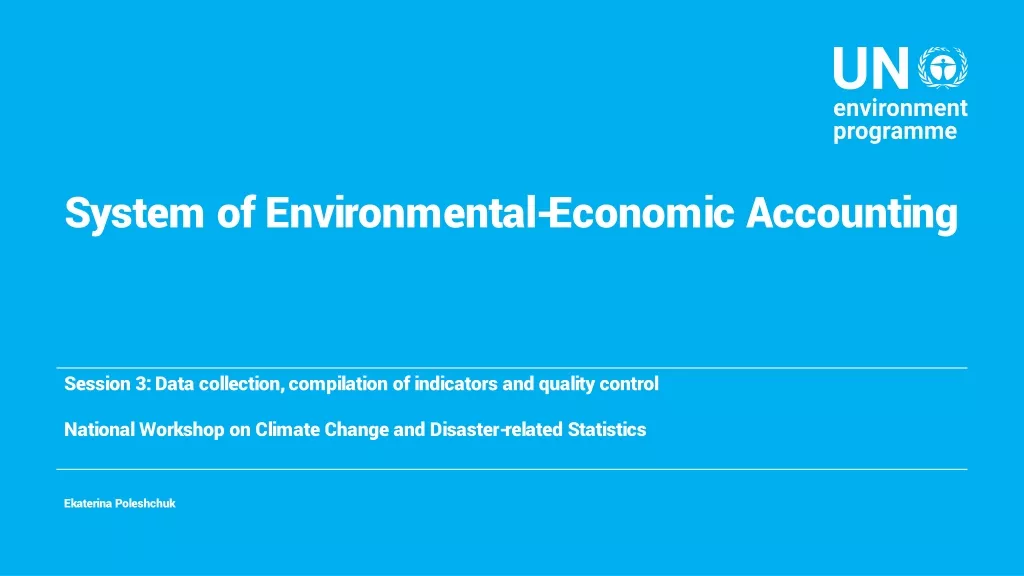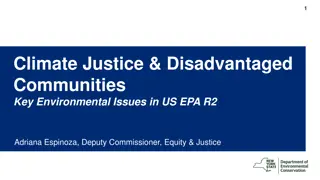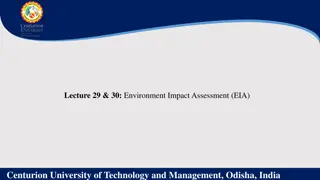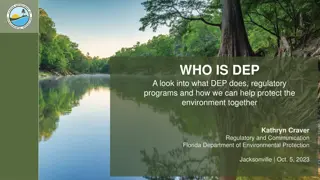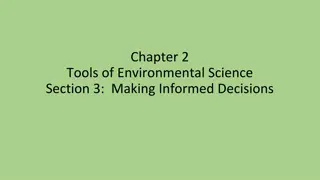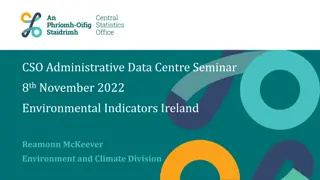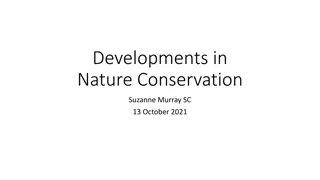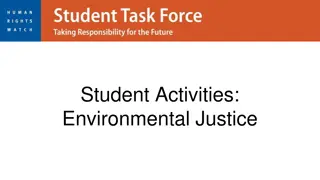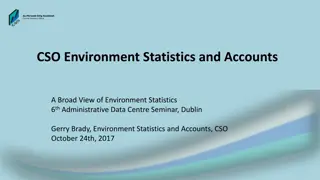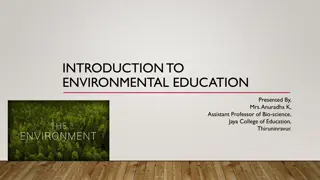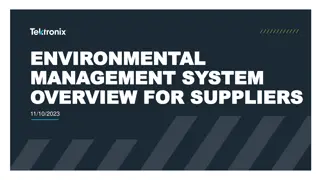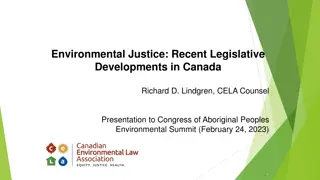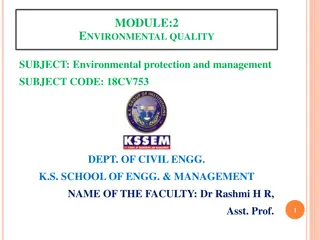Key Environmental Issues and Economic Impact
Addressing the significant challenges posed by climate change, biodiversity loss, water scarcity, and air pollution is crucial for sustainable economic growth. Failure to take action could lead to severe consequences for the environment, society, and global economy. Learn about the key environmental issues and the need for urgent measures to mitigate their impact.
Download Presentation

Please find below an Image/Link to download the presentation.
The content on the website is provided AS IS for your information and personal use only. It may not be sold, licensed, or shared on other websites without obtaining consent from the author.If you encounter any issues during the download, it is possible that the publisher has removed the file from their server.
You are allowed to download the files provided on this website for personal or commercial use, subject to the condition that they are used lawfully. All files are the property of their respective owners.
The content on the website is provided AS IS for your information and personal use only. It may not be sold, licensed, or shared on other websites without obtaining consent from the author.
E N D
Presentation Transcript
Key Environment Issues: An Introduction
Learning Outcomes After this topic you should be able to Understand the economic impact of environment issues Identify & discuss the key environment issues Understand the drivers of environmental change
The Problem There has been an unprecedented global economic growth especially since the 1920s Growth has been unevenly distributed & incurred significant cost to the environment World population has increased from 3bn in 1970 to 7bn today Its expected to reach 9bn by 2050 Serious economic, social and environmental consequences as a result
Environment and Economic Growth Environment problems will be the biggest challenge to economic growth by 2030 (OECD, 2017) Why?
The key environment issues Climate Change Biodiversity Water Air Quality
Climate Change: The Cost of Inaction https://www.youtube.com/watch?v=ifrHogDujXw Without further policies, by 2030 global emissions of greenhouse gases are projected to grow by a further 37%, and 52% to 2050. This could result in an increase in global temperature over pre-industrial levels in the range of 1.7-2.4 Celsius by 2050 leading to increased heat waves, droughts, storms and floods, resulting in severe damage to key infrastructure and crops.
Total Greenhouse Gas Emissions (by region) 1970-2050: Policy Inaction GtCO2 eq 80 70 60 50 ROW 40 30 BRIC 20 OECD 10 0 1970 80 90 2000 10 20 30 40 2050 Year
GHG reduction of 39 per cent by 2050: Policy Action GtCO2 eq 80 70 60 50 Total Baseline ROW 40 30 BRIC 20 10 OECD 0 1970 80 90 2000 10 Year 20 30 40 2050
An OECD simulation shows that actions by all countries are needed to achieve a 39% reduction in global greenhouse gas emissions by 2050 relative to 2000 levels. Such action would reduce GDP by 0.5% and 2.5% in 2030 and 2050 respectively, equivalent to a reduction in annual GDP growth of about 0.1 percentage points per annum on average. The more countries and sectors that participate in climate change mitigation action, the cheaper and more effective it will be to curb global greenhouse gas emissions. However, these costs are not distributed evenly across regions While OECD countries should take the lead, further co-operation with a wider group of emerging economies, the BRIICS countries (Brazil, Russia, India, Indonesia, China and South Africa) in particular, can achieve common environmental goals at lower costs.
Biodiversity http://www.youtube.com/watch?v=HA 3xNMJnFuo A considerable number of today s known animal and plant species are likely to be extinct, largely due to expanding infrastructure and agriculture, as well as climate change. Food and bio fuel production together will require a 10% increase in farmland worldwide with a further loss of wildlife habitat. Continued loss of biodiversity is likely to limit the Earth s capacity to provide the valuable ecosystem services that support economic growth and human well-being.
Sources of losses in mean species abundance to 2030 100% loss to agriculture loss to climate 90% loss to forestry 80% loss to fragmentation 70% loss to infrastructure 60% loss to nitrogen 0%- 50% Remaining diversity 2000 2030 2000 2030 2000 2030 2000 2030 OECD BRIC ROW WORLD
Water Water scarcity will worsen due to unsustainable use and management of the resource as well as climate change; the number of people living in areas affected by severe water stress is expected to increase by another 1 billion to over 3.9 billion https://www.youtube.com/watch?v=aFFVRg L4ymk
People Living in Areas of water stress, by level of stress 4,000 No 3,500 Low 3,000 Medium 2,500 Severe 2,000 1,500 1,000 500 - 2005 2030 2005 2030 2005 2030 OECD BRIC ROW
Air Quality https://www.youtube.com/watch?v=qBGvPZlu cLA Health impacts of air pollution will increase worldwide, with the number of premature deaths linked to ground-level ozone quadrupling and those linked to particulate matter more than doubling.
Fig: Annual mean PM10 concentrations, 2000-2030 Source: OECD Environmental Outlook Baseline, 2007.
Drivers of Environmental Change 1. Demographic Developments 2. Urbanisation 3. Economic Growth
Population and demographic developments Population growth is a key driver of local and global environmental change Due to Increased consumption of natural resources and land use Changes in wealth and age structure
Urbanisation Worlds population is becoming increasingly urbanised. In 1970 36% of world population lived in urban areas. By 2014 that share had reached 54% Urbanisation has positive and negative environmental consequences. On the positive side urbanisation can lead to the concentration of activities and allow for economies of scale and easier access (ie water & energy) On the negative side, a greater concentration of population can cause higher levels of air pollutions
Economic Growth Economic Growth and rising per capita income, if based on the increased use of natural resources exacerbate environmental pressures However other sources of growth, such as technological progress or improvement in education and human skills can decouple environmental pressures from economic growth
Links between economic activity and environmental pressures Energy use is driven by economic activity and technological developments As GDP is projected to quadruple so will energy use around 80% increase over global energy consumption in 2016
Possibility vs Plausibility Hamburg Climate Futures Outlook Technology dictates possibility Political and social barriers dictates feasibility Socio-economic factors help to define plausibility HCFO: joint analysis of our potential for dealing with climate change.
Summary There is global agreement that climate change, loss of biodiversity, access to fresh water and air pollution are serious issues that need to be addressed through international policy action Global coordination effort is required to find the most effective solutions The type of policy action matters (awareness campaigns, regulation, punitive legislation, carbon taxes, green technology)
Scope of the course Given the urgent need to address key environmental issues it is important to explore the different policy options available to tackle the problem The first section of the course addresses the effectiveness of a variety of policies employed in reducing environmental issues The last section is dedicated to examining specific issues including peak oil, deforestation and climate change
Required Reading Field & Field Ch.1 OECD (2012), Executive Summary , in OECD Environmental Outlook to 2050: The Consequences of Inaction, OECD Publishing, Paris. Read it online HERE https://doi.org/10.1787/env_outlook- 2012-3-en Global warming below 1.7 C is not plausible , reveals our study of the social drivers of decarbonisation -The Conversation
